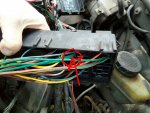timfost85
Well-Known Member
- Joined
- Mar 9, 2015
- Messages
- 47
- Vehicle Year
- 1993
- Transmission
- Manual
Hi all,
I'm not a frequent poster here, but I do really appreciate your advice when I have issues with my truck.
My 93 Ford Ranger (4l 4X4) wouldn't start the other day. I checked for spark, and narrowed it down to a fuel delivery problem. I lifted the bed and hardwired the fuel pump directly to a 12 volt battery. It did turn on. After I pressurized the line. I then turned on the vehicle and it started for a few minutes and shut itself off. After this, I would start it and it would only run for about 5 seconds. Since the fuel pump seems to work, I'm guessing that the fuel pressure regulator might have an issue?
I took a look at it today and pulled off the (vacuum?) line attached to it which was very loose. It seemed like there was some kind of fluid inside of it.
1. Am I on the right track with the FPR?
2. Is the (vacuum?) line to the FPR supposed to have fluid?
3. Anything I'm missing?
I also put a new battery and fuel filter in it. Thanks in advance for your help!
I'm not a frequent poster here, but I do really appreciate your advice when I have issues with my truck.
My 93 Ford Ranger (4l 4X4) wouldn't start the other day. I checked for spark, and narrowed it down to a fuel delivery problem. I lifted the bed and hardwired the fuel pump directly to a 12 volt battery. It did turn on. After I pressurized the line. I then turned on the vehicle and it started for a few minutes and shut itself off. After this, I would start it and it would only run for about 5 seconds. Since the fuel pump seems to work, I'm guessing that the fuel pressure regulator might have an issue?
I took a look at it today and pulled off the (vacuum?) line attached to it which was very loose. It seemed like there was some kind of fluid inside of it.
1. Am I on the right track with the FPR?
2. Is the (vacuum?) line to the FPR supposed to have fluid?
3. Anything I'm missing?
I also put a new battery and fuel filter in it. Thanks in advance for your help!













